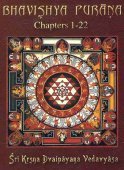Caturthi, Caturthī: 8 definitions
Introduction:
Caturthi means something in Hinduism, Sanskrit, Marathi. If you want to know the exact meaning, history, etymology or English translation of this term then check out the descriptions on this page. Add your comment or reference to a book if you want to contribute to this summary article.
Alternative spellings of this word include Chaturthi.
Images (photo gallery)
In Hinduism
Vaishnavism (Vaishava dharma)
Source: Pure Bhakti: Arcana-dipika - 3rd EditionCaturthī (चतुर्थी) refers to one of the various “lunar days” (tithi):—There are approximately 29.5 lunar days in a lunar month. The first fifteen days begin with the first phase of the waxing moon (pratipat) and end with the full moon (pūrṇimā). [...] In accordance with the lunar day, one would utter, [for example, caturthī-tithau].

Vaishnava (वैष्णव, vaiṣṇava) or vaishnavism (vaiṣṇavism) represents a tradition of Hinduism worshipping Vishnu as the supreme Lord. Similar to the Shaktism and Shaivism traditions, Vaishnavism also developed as an individual movement, famous for its exposition of the dashavatara (‘ten avatars of Vishnu’).
Ganapatya (worship of Ganesha)
Source: archive.org: Shiva Purana - (Ganesha)Caturthī (चतुर्थी) refers to the “fourth day” (e.g., in the dark half of the Bhādra month), according to the Śivapurāṇa 2.4.18 (“Gaṇeśa crowned as the chief of Gaṇas”).—Accordingly, as Śiva said to Gaṇeśa: “O Gaṇeśa, you are born in the first Prahara on the fourth day (caturthī) in the dark half of the Bhādra month at the auspicious hour of the moonrise. Since your form manifested itself from the good mind of Pārvatī, your excellent Vrata shall be performed on that Tithi itself or beginning from that day. It will be very auspicious and conducive to the achievement of all Siddhis. [...]”.
Ganapatya (गाणपत्य, gāṇapatya) represents a tradition of Hinduism where Ganesha is revered and worshipped as the prime deity (ishta-devata). Being a minor though influential movement, Ganapatya evovled, llike Shaktism and Shaivism, as a separate movement leaving behind a large body of literature.
Languages of India and abroad
Marathi-English dictionary
Source: DDSA: The Molesworth Marathi and English Dictionarycaturthī (चतुर्थी).—f (S) The fourth lunar day.
Source: DDSA: The Aryabhusan school dictionary, Marathi-Englishcaturthī (चतुर्थी).—f The fourth lunar day.
Marathi is an Indo-European language having over 70 million native speakers people in (predominantly) Maharashtra India. Marathi, like many other Indo-Aryan languages, evolved from early forms of Prakrit, which itself is a subset of Sanskrit, one of the most ancient languages of the world.
Sanskrit dictionary
Source: DDSA: The practical Sanskrit-English dictionaryCaturthī (चतुर्थी).—
1) The fourth day of a lunar fortnight.
2) The dative case (in gram.).
Source: Cologne Digital Sanskrit Dictionaries: Monier-Williams Sanskrit-English Dictionary1) Caturthī (चतुर्थी):—[from caturtha > catasṛ] a f. ([scilicet] rātri) the 4th day in a lunar fortnight, [Kātyāyana-śrauta-sūtra]
2) [v.s. ...] (metrically thi), [Varāha-mihira’s Yogayātrā v, 8]
3) [v.s. ...] ‘the 4th day of a marriage’ See rthī-karman
4) [v.s. ...] ([scilicet] vibhakti) the termination of the 4th case, dative case, [Pāṇini]
5) [v.s. ...] = tur-bhāgīyā, [Śulba-sūtra iii, 26]
6) Caturthi (चतुर्थि):—[from catasṛ] for thī q.v.
7) Caturthī (चतुर्थी):—[from catasṛ] b f. of tha q.v.
[Sanskrit to German]
Sanskrit, also spelled संस्कृतम् (saṃskṛtam), is an ancient language of India commonly seen as the grandmother of the Indo-European language family (even English!). Closely allied with Prakrit and Pali, Sanskrit is more exhaustive in both grammar and terms and has the most extensive collection of literature in the world, greatly surpassing its sister-languages Greek and Latin.
Kannada-English dictionary
Source: Alar: Kannada-English corpusCaturthi (ಚತುರ್ಥಿ):—
1) [noun] the fourth day after the full moon-day or new moon-day.
2) [noun] (gram.) the dative case (corresponding to the case expressed by the preposition 'to' of English).
Kannada is a Dravidian language (as opposed to the Indo-European language family) mainly spoken in the southwestern region of India.
See also (Relevant definitions)
Starts with: Caturthi-amavasya, Caturthika, Caturthikarman, Caturthiprabhriti, Caturthisamasa, Caturthitritaya, Caturthivrata.
Ends with (+3): Alolacaturthi, Angarakacaturthi, Angari Caturthi, Avighnavinayakacaturthi, Ganapatacaturthi, Ganeshacaturthi, Gauricaturthi, Karakacaturthi, Kundacaturthi, Mahaganeshacaturthi, Mahavinayakacaturthi, Nagacaturthi, Samkatacaturthi, Sankashtacaturthi, Sankaticaturthi, Shravanashuklacaturthi, Tilacaturthi, Umacaturthi, Varadacaturthi, Vinayakacaturthi.
Full-text (+36): Caturthikarman, Kundacaturthi, Tilacaturthi, Umacaturthi, Karakacaturthi, Samkatacaturthi, Ganeshacaturthi, Gauricaturthi, Tithi, Yavacaturthi, Vinayakacaturthi, Caturthi-amavasya, Caturthiprabhriti, Varadacaturthi, Angari Caturthi, Samkashtacaturthivratakatha, Samkashtacaturthikatha, Turi, Samkashtaharacaturthivratakalanirnaya, Samkataharacaturthivrata.
Relevant text
Search found 26 books and stories containing Caturthi, Caturthī; (plurals include: Caturthis, Caturthīs). You can also click to the full overview containing English textual excerpts. Below are direct links for the most relevant articles:
Taittiriya Upanishad Bhashya Vartika (by R. Balasubramanian)
Garga Samhita (English) (by Danavir Goswami)
Verse 4.19.80 < [Chapter 19 - A Thousand Names of Srī Yamunā]
Chaitanya Bhagavata (by Bhumipati Dāsa)
Verse 1.14.24 < [Chapter 14 - The Lord’s Travel to East Bengal and the Disappearance of Lakṣmīpriyā]
Vakyapadiya of Bhartrihari (by K. A. Subramania Iyer)
Verse 3.7.129 < [Book 3 - Pada-kāṇḍa (7): Sādhana-samuddeśa (On the Means)]
Verse 3.7.130 < [Book 3 - Pada-kāṇḍa (7): Sādhana-samuddeśa (On the Means)]
Verse 3.7.115 < [Book 3 - Pada-kāṇḍa (7): Sādhana-samuddeśa (On the Means)]
Sahitya-kaumudi by Baladeva Vidyabhushana (by Gaurapada Dāsa)
Text 5.12 < [Chapter 5 - Second-rate Poetry]
Text 10.83 [Atiśayokti] < [Chapter 10 - Ornaments of Meaning]
Text 2.32 < [Chapter 2 - The Natures of Words (śabda)]
Vasudevavijaya of Vasudeva (Study) (by Sajitha. A)
Kāraka (e): Sampradāna < [Chapter 3 - Vāsudevavijaya—A Grammatical Study]
Kāraka in Grammar (Introduction) < [Chapter 3 - Vāsudevavijaya—A Grammatical Study]
Tatpuruṣa-samāsa (Compound) < [Chapter 3 - Vāsudevavijaya—A Grammatical Study]
Related products


